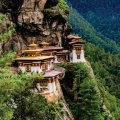TAKTSHANG (TIGER'S NEST)
Go there and contact
Bhutan's most famous monastery, clinging to the black rocks, offering tours of the various statues in the 3 temples
This is Bhutan's most famous monastery, the one you'll see on every postcard of the destination. It's undoubtedly one of the most important pilgrimage sites in the Himalayas, and a visit is a must. Around 5 km from Kyichu Lhakhang, on the right-hand side of the road, overlooking the valley, you'll see the Taktsang hermitage, "the Tiger's nest", perched at 3,070 m above sea level. Up there, as if suspended in the air, the temple clings to the black rocks. After years of reconstruction following a devastating fire in 1998, the temple is once again open to the public.
Access and paths. Although the hermitage may seem inaccessible, pilgrims and visitors alike can reach it via several footpaths. It takes about 2h30 to walk there. However, people with heart problems and pregnant women are advised to refrain from walking up there, as the hike is not difficult in itself, but the difference in altitude is considerable (1 km) and you're still at an altitude of 3,000 metres! If you're not physically up to the challenge, you can always ride a horse. Horses are available near the parking lot where the main trail starts. It leaves the road, crosses a river, gets lost for a while in the middle of fields before starting a steep climb through the forest. To get close to the magic of Taktsang, allow 1 to 2 hours' walk through a forest of rhododendrons and lichen trees before reaching the first plateau, at 2,900 m. Halfway up, you'll find a mountain hut. Halfway up, there's a restaurant-cafeteria run by the Ministry of Tourism where you can hydrate and eat. It offers an impressive view of the monastery, which you can observe while enjoying a well-deserved cup of tea or coffee! A few snacks are also available to give you a little extra energy.
The second part of the route is steeper, but also faster (allow around 45 minutes). The path climbs above the temple and, at a bend, a small chörten topped by a few prayer flags offers a bird's-eye view of the monastery's golden roofs. The effect is breathtaking, and makes you wonder how the monks ever got the materials they needed to build their sanctuary here. After a profusion of steps and switchbacks that take you past a small chapel and a waterfall, the effort is amply rewarded when the landscape opens up like a window onto the lair. Behind the multicolored prayer flags, the white monastery clinging to the rock stands out perfectly and is a real eye-catcher. One last effort before entering (again!): here, as in all the country's temples, you are forbidden to take photos, and must leave your bag and camera in a locker at the entrance.
According to tradition, Padmasambhava, or Guru Rinpoche - in his wrathful form of Dorje Dolo - having heard the valley's inhabitants complaining about the yoke of a demon, Singey Samdrup, rode a tigress (the manifestation of his wife Yeshe Tsogyal) and flew there to defeat the demon and make him the valley's protector. After the miracle was accomplished, he settled in one of the caves on the wall to meditate for three months and convert the valley to Buddhism. The saintly Milarepa is also said to have meditated here. All the temples were built over the centuries, but the main building, attributed to the fourth desi (non-religious administrator), Tenzing Rabgye, dates from the 17th century. The chapels, the first of which dates back to the 14th century, were added over the centuries and monks retreat here for a period of three years, three months and three days.
Once inside, before beginning your tour of the 3 temples, turn right and look for the relic stone. The principle is simple: close your eyes and try to place your thumb in the small hole in the rock. Then open your eyes. If you succeed, you'll have your guide's blessing! Is your thumb next to the hole? Better luck next time! The first temple, the Dubkhang, was built around the cave where Guru Rinpoche meditated for three months. The cave, protected by a gate, is only open to pilgrims once a year. Inside the temple, the central statue depicts the arrival of Padmasambhava on the tigress' back, equipped with the dorje, the lightning-shaped weapon, and the phurbu, the ritual dagger. The tour continues on the upper floor, just above the cave. A much larger room contains a superb statue of Guru Rinpoche. The statue is highly revered by pilgrims, and has been attributed words. A beautiful statue of Tenzing Rabgye, fourth desi and founder of the main chapels, is also present in the hall. Remarkable paintings illustrate the various manifestations of Padmasambhava. The third, much larger temple is also dedicated to Guru Rinpoche: statues and paintings illustrate his various aspects and teachings. The small adjoining chapel houses a gigantic statue of Dorje Dolo. On the floor, a glass panel reveals the bowels of a sacred cave. All around and up to the summit, numerous small buildings and chapels remind us that this is first and foremost a place of retreat.
